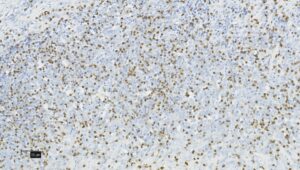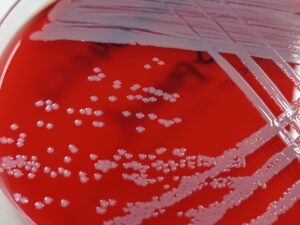Research into small animal skin disease
12 March 2025
Small animal skin disease
BSAVA PetSavers, and its previous manifestation the Clinical Studies Trust Fund, is celebrating 50 years of providing funding for veterinary clinical research across a wide range of topics, including dermatological conditions.
In his 2014 review of the first 40 years of BSAVA PetSavers-funded research in dermatology and dermato-endocrinology which has been used as a source for this article.1 Professor Keith Thoday from the University of Edinburgh acknowledged the immense contribution this funding has made over the years both to his work and that of many other dermatologists. Having commenced his career investigating what was then known as feline endocrine alopecia, now called feline acquired symmetric alopecia, BSAVA PetSavers’ funding allowed him to identify thyroxine and triiodothyronine as the main feline thyroid hormones and to determine the effects of factors such as age, breed and sex on their plasma concentrations.2 This funding was then able to support others in his Edinburgh team, including Professor Carmel Mooney and Dr Darren Foster as they started their research careers looking at the newly emerging condition of feline hyperthyroidism. Canine dermatopathies were not left out as Professor Mooney and Professor Ian Ramsey have both investigated endocrine aspects of canine skin disease with the support of BSAVA PetSavers grants.
Infectious skin diseases
Research into infectious skin disease of small animals has also been supported by BSAVA PetSavers. In 1983, Professor Rosalind Gaskell and Dr Derrick Baxby of the University of Liverpool were awarded grants to elucidate aspects of feline cowpox, a potentially serious zoonosis and which at the time was a little understood disease. More recently, in 2014, Professor Danielle Gunn-Moore at the University of Edinburgh received funding for a project assessing tissue macrophages in feline tuberculosis. Feline mycobacterial disease is another serious disease of zoonotic potential, which often presents with skin lesions and has only come to wider recognition in recent years. Her work was of significant importance in identifying an association between a commercial raw food diet and the presence of Mycobacterium bovis infection in an outbreak in cats (Figure 1).3

Figure 1. Positive immunohistochemistry for calprotectin, a marker expressed by monocytes and neutrophils, from a cutaneous lesion of a cat with culture-confirmed Mycobacterium bovis infection. Magnification x200.
Continuing with skin disease associated with microorganisms, the yeast Malassezia pachydermatis is now recognized as a major contributory pathogen in canine skin disease and notably otitis externa. Professor Ross Bond, from the Royal Veterinary College, has played a leading role in its investigations, which started with Clinical Studies Trust Fund support for his residency in 1992, and further BSAVA PetSavers grants from 1996.
In a BSAVA PetSavers-funded study in 2021, Professor Bond and colleagues demonstrated the occurrence of fungal dysbiosis following antibiotic monotherapy for canine otitis externa. Dogs treated successfully with either topical fluoroquinolanes or topical piperacillin/tazobactam showed significant increases in their M. pachydermatis count following treatment. This work emphasized the importance of monitoring ears for yeast overgrowth following successful treatment of otitis externa, which is of clinical significance to almost anyone in first-opinion small animal practice.4
An earlier BSAVA PetSavers-funded study by Professor Bond showed the benefits of transverse sectioning in evaluating skin biopsy specimens from alopecic dogs. Although transverse sectioning has revolutionized the assessment of human alopecia, only vertical sectioning is routinely performed in veterinary laboratories. The benefits of transverse sectioning include being able to demonstrate every hair in the specimen, and thereby quantitively evaluate follicular activity. Transverse sectioning was shown to confer significant benefits, and to complement more conventional vertical sectioning particularly when subtle abnormalities distorted compound follicle architecture, hair cycle arrest, or when relatively few adnexal structures were affected. This relatively simple modification of sample processing with no additional risk for the patient is recommended when evaluating biopsy specimens from alopecic dogs and has a relevant application for a large number of animals.5 This study and subsequent publication won Professor Bond the BSAVA PetSavers Veterinary Achievement Award of 2022 for work most relevant to veterinary practice.
“BSAVA PetSavers funding fills an important niche, given their interest in work of direct relevance to veterinary practice. This study was a total blast to perform, and it is most rewarding that BSAVA PetSavers found it to be of value.” Professor Ross Bond, RVC
We are all becoming ever more aware and increasingly concerned about antimicrobial resistance (AMR) and its impact on our ability to manage disease in our patients. BSAVA PetSavers has supported research with a particular focus in this area – both to look at the prevalence of AMR and also ways of combating it. As we all now live and work in this age of AMR, the potential of novel biological agents in combating bacterial skin disease should not be underestimated.
Canine Staphylococcus pseudintermedius
In 2016, BSAVA PetSavers funded a project at the University of Liverpool looking at the resistance of canine staphylococcal pseudintermedius to selected topical and systemic antimicrobials in the UK. Findings were submitted as a clinical research abstract for BSAVA Congress 2020 and confirmed PCR as the ‘gold-standard’ for identifying the presence of MRSP and MSSP isolates.6
Bacteria produce a range of antimicrobial peptides, the most diverse being bacteriocins which are ribosomally synthesized peptides that display antimicrobial activity against bacteria closely related to the producer strain, but to which the producer strain itself is resistant. In 2018, a BSAVA PetSavers-funded master’s degree by research at the University of Edinburgh investigated potential therapeutic options derived from the normal microflora to combat bacterial skin infections in cases of canine atopic dermatitis, and identified several classes of bacteriocins that may represent valuable tools in the future fight against staphylococcal disease. Student Logan Newstead with supervision by Dr Gavin Paterson used a combination of culture-based and quantifiable assays, alongside comparative genomic analysis of inhibitory and non-inhibitory isolates to allow for the identification of AMP-related gene clusters. This identified antimicrobial peptides produced by commensal staphylococci from the skin of healthy dogs, which were then screened for inhibitory activity against Staphylococcus pseudintermedius (Figure 2).7 Further work is needed to elucidate those individual bacteriocins which are going to be most valuable and evaluate potential cytotoxic effects which might render some unsuitable.

Figure 2. Staphylococcus pseudintermedius on blood agar
Researching otitis in dogs
Dr Paterson has recently supervised another master’s degree funded by BSAVA PetSavers investigating the potential of phage therapy in combating otitis in dogs caused by Pseudomona aeruginosa – that scourge of many a small animal practitioner in general practice. Student Shannon Street isolated potential phage therapy candidates which, although showing a limited host range, could be used as part of a phage ‘cocktail’ for the future treatment of bacterial skin disease.8
Dr Vanessa Schmidt at the University of Liverpool has also supervised a number of student projects funded by BSAVA PetSavers, this time involving undergraduates who benefited from grants that gave them a ‘taster’ of clinical research. Shauna Creamer won the BSAVA PetSavers clinical abstract award in 2024 for presenting her work on the potential for anti-microbial activity of the cutaneous microbiome, which identified several candidates demonstrating consistent inhibition of clinical S. pseudintermedius.9 Still ongoing is Christy Dixon’s project exploring the dog microbiome for therapeutic potential in the treatment of canine bacterial pyoderma.
It remains to be seen which of these novel approaches to antimicrobial therapy will come to fruition, but BSAVA PetSavers continues to provide support for ground-breaking work, and as can be seen, plays its part in launching careers of researchers of the future.
Supporting more BSAVA PetSavers research
At BSAVA PetSavers we are immensely proud that our funding has helped advance the care of pets with skin diseases. We have spent over £170,000 on clinical research into skin disease alone in the last 10 years. To fund ground-breaking research like that done by the researchers mentioned above, we rely on the generosity of our donors, supporters, fundraisers, legators and sponsors. Please support us to continue this life changing work for pets by scanning this QR code to donate:

Donate here
References
1. Thoday KL (2014) PetSavers support for research into veterinary dermatology and dermato-endocrinology. BSAVA Companion, May 26–27
2. Thoday KL, Seth J and Elton RA (1984) Radioimmunoassay of serum total thyroxine and triiodothyronine in healthy cats: assay methodology and effects of age, sex, breed, heredity and environment. Journal of Small Animal Practice 25, 457–472
3. O’Halloran C, Ioannidi O, Nicki Reed et al. (2019) Tuberculosis due to Mycobacterium bovis in pet cats associated with feeding a commercial raw food diet. Journal of Feline Medicine and Surgery 21, 667-681
4. Juhola J, Brennan EA, Ferguson A et al. (2024) Fungal dysbiosis following antibacterial monotherapy in canine otitis externa. Journal of Small Animal Practice, early view. DOI 10.1111/jsap.13801
5. Bond R, Hendricks A, Patterson-Kane J, Stevens K and Brooks Brownlie HW (2021) Transverse sectioning in the evaluation of skin biopsy specimens from alopecic dogs. Journal of Small Animal Practice 62, 244–252
6. Donovan Z (2020) Resistance of canine Staphylococcus pseudintermedius to selected topical and systematic antimicrobials in the UK. BSAVA Congress Proceedings 399; doi. 10.22233/9781910443774.51.3
7. Newstead L (2020) Exploiting the healthy microflora to develop new treatments for Staphylococcus pseudintermedius infection in canine atopic dermatitis. Thesis, University of Edinburgh
8. Street S (2024) Canine Pseudomonas aeruginosa infections. BSAVA Companion, September 26–27
9. Creamer S (2023) An investigation into the antimicrobial properties of canine skin microflora. BSAVA Congress Proceedings; doi. 10.22233/9781913859152.42.3
